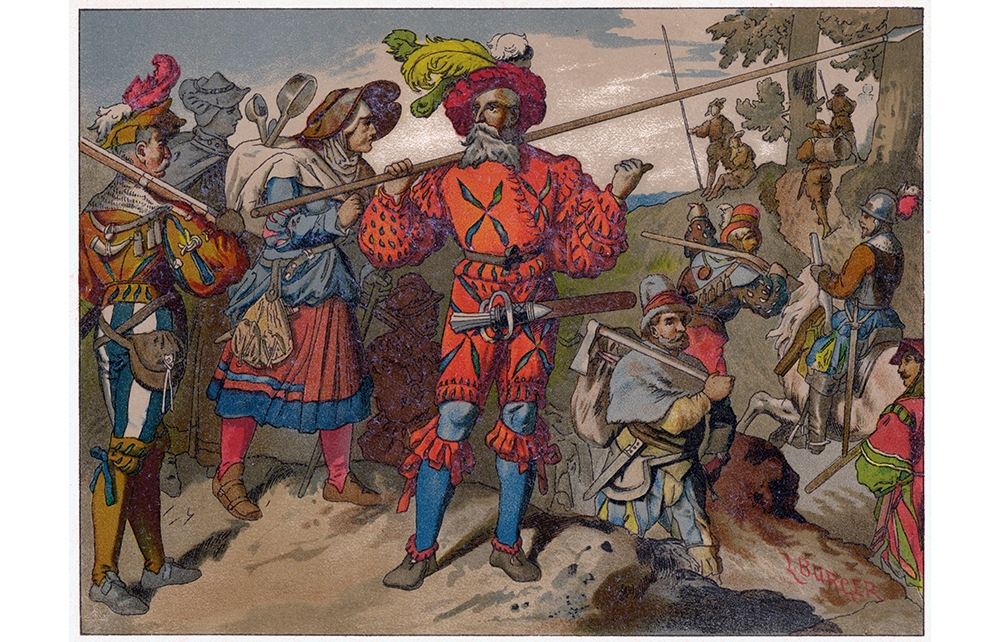It is the contention of Peter Wilson, professor of the history of war at Oxford University and the author of an acclaimed history of the Thirty Years’ War, that military historians have focused too much on the German wars of the 20th century in trying to understand German ‘militarism’ as a distinctive characteristic – a ‘genius for war’ imitated by others. As he points out, Germany and Austria lost the first world war, and Germany, with Austria now attached, lost the second as well. A ‘genius for war’ evidently needs some rethinking.
Wilson wants to place these modern wars in perspective, stretching back to the 15th century. To understand how German lands (the small German states, Austria and Switzerland) reached their modern destinations entails studying the long journey from medieval Europe to the present. The book moves from the struggles of Reformation central Europe, through the Thirty Years’ War, the dynastic conflicts of the 18th century and revolutionary and Napoleonic warfare before reaching the age in which Habsburg Austria, with its large (non-German) empire, and Prussia became the dominant German polities. Switzerland almost disappears, its ‘perpetual neutrality’ endorsed by the Great Powers in 1815 and respected ever since, even by Hitler, who briefly toyed with occupation.
From 1831 to 1973, the French Foreign Legion counted 40 per cent of its recruits from German lands
While each century produces fresh and fascinating details on military organisation, recruitment, tactics, weaponry and attitudes to warfare, there is much less in Iron and Blood on the evolution of German military culture and practice over time than its introduction seems to promise. Every age is particular to itself, as it should be, but what this contributes to understanding the modern German military as a product of deep and diverse historical roots is not clear. The Napoleonic wars seem the natural break point – after which the development of the modern military establishment in the German lands can be traced and evaluated with greater historical precision; and indeed most of the book focuses on the past 200 or so years, taking the story up to Germany’s participation in Nato.
What is clear is just how bellicose German-speakers could be. Much of the time was spent fighting each other until internecine warfare ended in 1866, with the Prussian defeat of the Habsburgs. But large numbers of men from the German lands also volunteered to fight in other peoples’ wars. Switzerland alone may have supplied two million between 1450 and 1850, and the Swiss still guard the Vatican City. German units were in demand from more powerful neighbours, and were either paid, or promised a share of booty. They could be unreliable recruits, but there must have been something about their reputation for fighting to explain why they were so sought after. Wilson tells us that the French Foreign Legion, from 1831 to 1973, counted 40 per cent of its recruits from German lands.

Nevertheless, opting for a soldier’s life before the age of professional forces was hazardous. If it brought the prospect of a job in hard times, discipline was tough and rough, uniforms often scanty, pay irregular, booty unpredictable and casualty rates exceptionally high (anywhere between a third and two-thirds of those in the field). German recruits could be subjected to grotesque punishments for any slacking – being made to eat their socks or their own excrement. The standard Prussian practice with deserters was to force them to run the gauntlet. A penalty of 30 ‘runs’ usually ended in death. Only in the 19th century did most of these barbarous practices die out, but as late as the second world war, German soldiers were shot for desertion or dereliction of duty in huge numbers, while those who broke down psychologically were sent to work camps, where their mental state certainly worsened.
Wilson is keen throughout to avoid what he sees as a western obsession with the rise of Prussia as the central story of German military history. But while it is important to remember that the Habsburg empire was the dominant German power for centuries, larger than Prussia (though only because of its majority non-German population) and constantly at war, it was also the case that the Prussian general staff system, pattern of conscription, infantry manuals, focus on logistics and technical education made its army a model in the field and widely followed abroad.
Wilson rightly contends that the problem for German warfare, from the defeat of France in 1871 onwards, was not technical capability but the perennial failure to match military competence and planning with a broader strategic vision. Thus, when the hope for a quick battle of annihilation in 1914 failed to materialise, there was no effective Plan B, except to dig in and hope for the best. In 1940, the comprehensive defeat of France was followed by the strategic delusion that somehow Germany could take on the rest of the world. War against the Soviet Union and the United States was the model for German strategic failure. Even then, it took four years of hard-fought battle to defeat German forces, who to the end deserved their reputation for tactical skill and fighting ability. The German generals who ended up in the United States providing detailed reports on German methods might well have reminded their captors that shooting first and asking questions later promised strategic bankruptcy.
Iron and Blood is not an easy read. Across five centuries there is a plethora of battles, wars, commanders and monarchs that will challenge even the most diligent student of war. For all the book’s solid research and comprehensive coverage, it is still difficult to reach the wood beyond the trees.






Comments